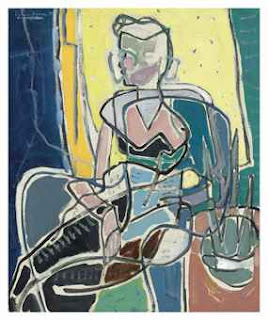Robert Rauscheberg's 1967 Lithograph print "Booster" was the first of several things. It was the largest hand made lithographic print of it's time, requring two lithographic stones, one after another, at the Gemini studio in LA. It was also the first print to juxtapose silk screening with lithography. What started as an experiment ended up as a turning point for both the artist and Gemini.
Are there any artists left today who are breaking ground on new ways to paint, print, sculpt, or anything? Is there anything left undone? Of course the art world underwent change in the past 50 years, since artists like Rauschenberg were around doing never-before-attempted experiments, but I wonder if there are still materials, techniques, or tools that have yet to be unveiled. I guess it's not all that likely...
It's hard not to find something you like in an exhibit like "Rauschenberg at Gemini" (currently showing at the Philbrook museum in Tulsa). The artist did so much and in a countless variety of materials and tools. There is cardboard, textile, traditional prints, prints on polyurethane sculptures, prints onto clear vinyl curtains and draperies. This is an artist who was not interested in maintaining a consistent theme or style, nor did he seem to care to much about public reception...
What did he care about? The potential within ordinary materials. He didn't believe in confining art to paint, clay and canvas. He embraced a range of ordinary items and incorporated them freely into his work, saying "I've always been more attracted to familiar or ordinary things because I find them a lot more mysterious." And, really, what do we know about the possibilities of rope, cardboard or metals to become art work? Nothing, unless we try...
"You begin with the possibilites of the material." - Robert Rauscheberg
It is so deliciously affirming to have a world-renowned artist like Rauschenberg advocating all of the most valuable things I have learned from Reggio Emilia, the things I try to impart to children when I teach art, and what I believe most deeply when I observe and create art myself.
 |
| "Booster" 1967 |
It's hard not to find something you like in an exhibit like "Rauschenberg at Gemini" (currently showing at the Philbrook museum in Tulsa). The artist did so much and in a countless variety of materials and tools. There is cardboard, textile, traditional prints, prints on polyurethane sculptures, prints onto clear vinyl curtains and draperies. This is an artist who was not interested in maintaining a consistent theme or style, nor did he seem to care to much about public reception...
What did he care about? The potential within ordinary materials. He didn't believe in confining art to paint, clay and canvas. He embraced a range of ordinary items and incorporated them freely into his work, saying "I've always been more attracted to familiar or ordinary things because I find them a lot more mysterious." And, really, what do we know about the possibilities of rope, cardboard or metals to become art work? Nothing, unless we try...
"You begin with the possibilites of the material." - Robert Rauscheberg
It is so deliciously affirming to have a world-renowned artist like Rauschenberg advocating all of the most valuable things I have learned from Reggio Emilia, the things I try to impart to children when I teach art, and what I believe most deeply when I observe and create art myself.























